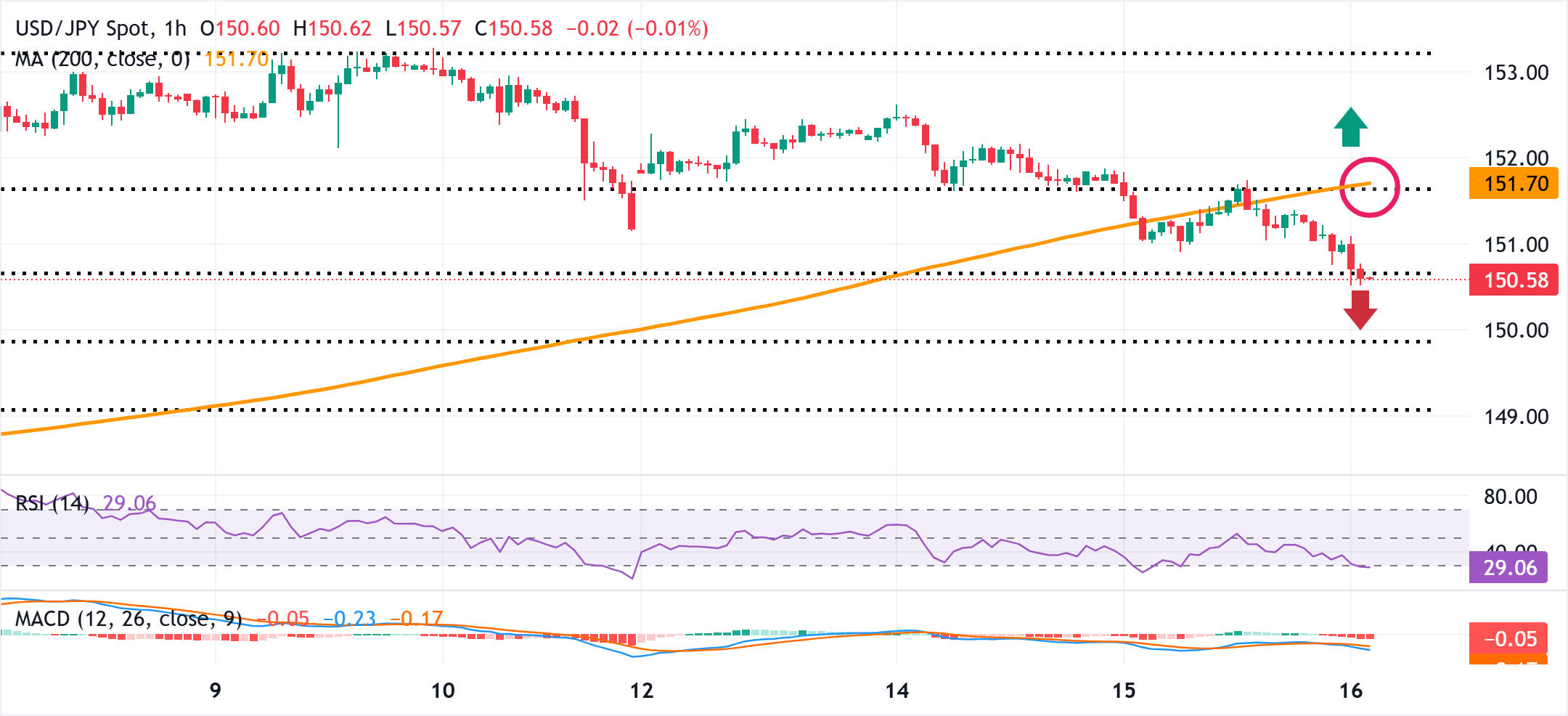Created
: 2025.10.16














![]() 2025.10.16 11:36
2025.10.16 11:36
The Japanese Yen (JPY) remains on the front foot against its American counterpart for the third consecutive day and climbs to an over one-week high during the Asian session on Thursday. The ruling Liberal Democratic Party's (LDP) coalition split with the Komeito jeopardized Sanae Takaichi's, who is known for her pro-stimulus stance, bid to become the country's first woman Prime Minister. This resulted in the reversal of the Takaichi trade, which, in turn, has been a key factor underpinning the JPY. Adding to this, escalating US-China trade tensions, rising geopolitical risks, and concerns about a prolonged US government shutdown drive safe-haven flows towards the JPY.
Meanwhile, traders have been pricing in the possibility that the Bank of Japan (BoJ) may delay further tightening in the wake of a heightened domestic political uncertainty. This might hold back the JPY bulls from placing aggressive bets amid a positive risk tone. Nevertheless, the BoJ is expected to stick to its policy normalization path and hike interest rates by the year-end. This marks a significant divergence in comparison to bets that the US Federal Reserve (Fed) will lower borrowing costs two more times this year. The latter keeps the US Dollar (USD) bulls on the defensive and backs the case for an extension of the USD/JPY pair's recent pullback from an eighth-month high.

The overnight downfall dragged the USD/JPY pair below the 200-hour Simple Moving Average (SMA). The subsequent slide below the 150.70 area, or the 38.2% Fibonacci retracement level of the recent solid recovery from the October monthly swing low, could be seen as a key trigger for bearish traders. However, oscillators on the daily chart are still holding in positive territory, suggesting that spot prices could find some support near the 150.00 psychological mark. The said handle coincides with the 50% Fibo. retracement level, which, if broken decisively, might expose the 61.8% Fibo. retracement level, around the 149.15 region.
On the flip side, any recovery attempt might now confront an immediate barrier near the 151.00 mark. A sustained move beyond could lift the USD/JPY pair further, though it is more likely to remain capped near the 151.65 confluence hurdle. The said area comprises the 200-hour SMA breakpoint and the 23.6% Fibo. retracement level. However, some follow-through buying would negate any near-term negative bias and allow spot prices to reclaim the 152.00 round figure before climbing further towards the weekly swing high, around the 152.60 region.
The Japanese Yen (JPY) is one of the world's most traded currencies. Its value is broadly determined by the performance of the Japanese economy, but more specifically by the Bank of Japan's policy, the differential between Japanese and US bond yields, or risk sentiment among traders, among other factors.
One of the Bank of Japan's mandates is currency control, so its moves are key for the Yen. The BoJ has directly intervened in currency markets sometimes, generally to lower the value of the Yen, although it refrains from doing it often due to political concerns of its main trading partners. The BoJ ultra-loose monetary policy between 2013 and 2024 caused the Yen to depreciate against its main currency peers due to an increasing policy divergence between the Bank of Japan and other main central banks. More recently, the gradually unwinding of this ultra-loose policy has given some support to the Yen.
Over the last decade, the BoJ's stance of sticking to ultra-loose monetary policy has led to a widening policy divergence with other central banks, particularly with the US Federal Reserve. This supported a widening of the differential between the 10-year US and Japanese bonds, which favored the US Dollar against the Japanese Yen. The BoJ decision in 2024 to gradually abandon the ultra-loose policy, coupled with interest-rate cuts in other major central banks, is narrowing this differential.
The Japanese Yen is often seen as a safe-haven investment. This means that in times of market stress, investors are more likely to put their money in the Japanese currency due to its supposed reliability and stability. Turbulent times are likely to strengthen the Yen's value against other currencies seen as more risky to invest in.
![]()
Created
: 2025.10.16
![]()
Last updated
: 2025.10.16

FXStreet is a forex information website, delivering market analysis and news articles 24/7.
It features a number of articles contributed by well-known analysts, in addition to the ones by its editorial team.
Founded in 2000 by Francesc Riverola, a Spanish economist, it has grown to become a world-renowned information website.
We hope you find this article useful. Any comments or suggestions will be greatly appreciated.
We are also looking for writers with extensive experience in forex and crypto to join us.
please contact us at [email protected].
Disclaimer:
All information and content provided on this website is provided for informational purposes only and is not intended to solicit any investment. Although all efforts are made in order to ensure that the information is correct, no guarantee is provided for the accuracy of any content on this website. Any decision made shall be the responsibility of the investor and Myforex does not take any responsibility whatsoever regarding the use of any information provided herein.
The content provided on this website belongs to Myforex and, where stated, the relevant licensors. All rights are reserved by Myforex and the relevant licensors, and no content of this website, whether in full or in part, shall be copied or displayed elsewhere without the explicit written permission of the relevant copyright holder. If you wish to use any part of the content provided on this website, please ensure that you contact Myforex.
Myforex uses cookies to improve the convenience and functionality of this website. This website may include cookies not only by us but also by third parties (advertisers, log analysts, etc.) for the purpose of tracking the activities of users. Cookie policy